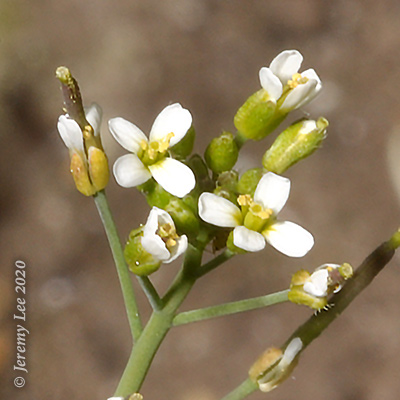
 |
|
Scientific Classifications explained » Amphibians » Ants » Aphids » Bees » Beetles » Birds » Bugs » Butterflies » Caterpillars » Damselflies » Dragonflies » Earwigs » Flies » Frog/Leafhoppers » Fungi » Galls » Grasshoppers » Harvestmen » Hoverflies » Lacewings » Ladybirds » Leaf Mines » Lichens » Mammals » Millipedes » Mosses » Moths » Sawflies » Slugs » Snails » Spiders » Trees » Wasps » Wild Flowers » Woodlice |
UK Nature > Wild Flowers > White Wild Flowers > Arabidopsis thaliana

Scientific Name: Arabidopsis thaliana Common Name: Thale Cress Arabidopsis thaliana, more commonly known as Thale Cress, Wall Cress or Mouse-ear Cress, is an annual but it usually germinates in the autumn and overwinters as a leaf rosette. In April or May at the latest the rosette grows a flowering stem with flowers at the top, and the first fruits soon form. Thale cress’s white flowers are only a couple of millimetres in diameter, which is too small to attract insects, but seed-production is ensured by self-pollination. If drought does not seal the plant’s fate early it can go on to grow and branch until early summer as it ripens its seeds. Thale cress is like the floral equivalent of the fruit fly (Drosophila melanogaster): both are cultivated in laboratories around the world and used in genetic research. It is easy to care for, fast-growing, small and very fertile so it is a wonderful model organism to explain many of the basic phenomena of the plant kingdom. It has a simple genome with only five pairs of chromosomes (e.g. a human has twenty-three pairs). This insignificant weed can be used to study useful phenomena in agriculture and economics more broadly. The basic genetic mechanisms of growth, flowering and seed production are the same throughout the plant kingdom, so research into thale cress can be applied to other useful plants. |
|

https://www.uknature.co.uk is a website dedicated to showing the immense diversity of UK nature and wildlife. Our vast range of habitats, from lowland arable to snow covered mountains, from storm-ravaged coastlines to peaceful inland freshwater lakes and rivers, from dry, sandy heaths to deciduous and coniferous forests, all these habitats contribute to the abundance of UK nature. We have wild birds in huge numbers either residing or visiting our shores (597 recorded species as at July 2013) and we must also not forget the humble back garden with its grass lawns, flower beds filled with nectar rich flowers, shrubs and trees, all designed to attract huge numbers of insects such as bees, moths, butterflies and hoverflies; and finally the small ponds which provide safe havens for frogs, toads, newts and even slow worms and grass snakes. www.uknature.co.uk is the showcase for my personal passion, photographing uknature in all its glory. I sincerely hope you all enjoy the fruits of my labours. This site and all images contained therein is © Jeremy Lee 2004 - 2021. All Rights Reserved. Site design by Jeremy Lee. Site development & IT Support by Stuart Lee. |